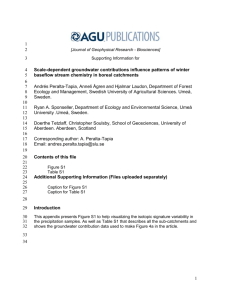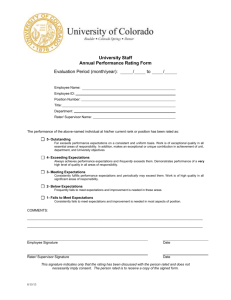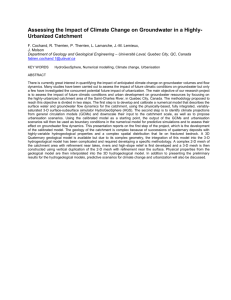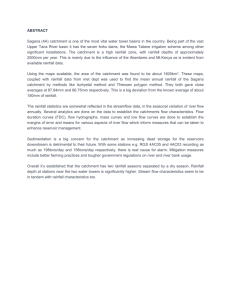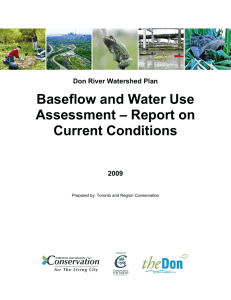Low Flow Modelling to detect rating PERTURBATIONs G.H. Macky
advertisement
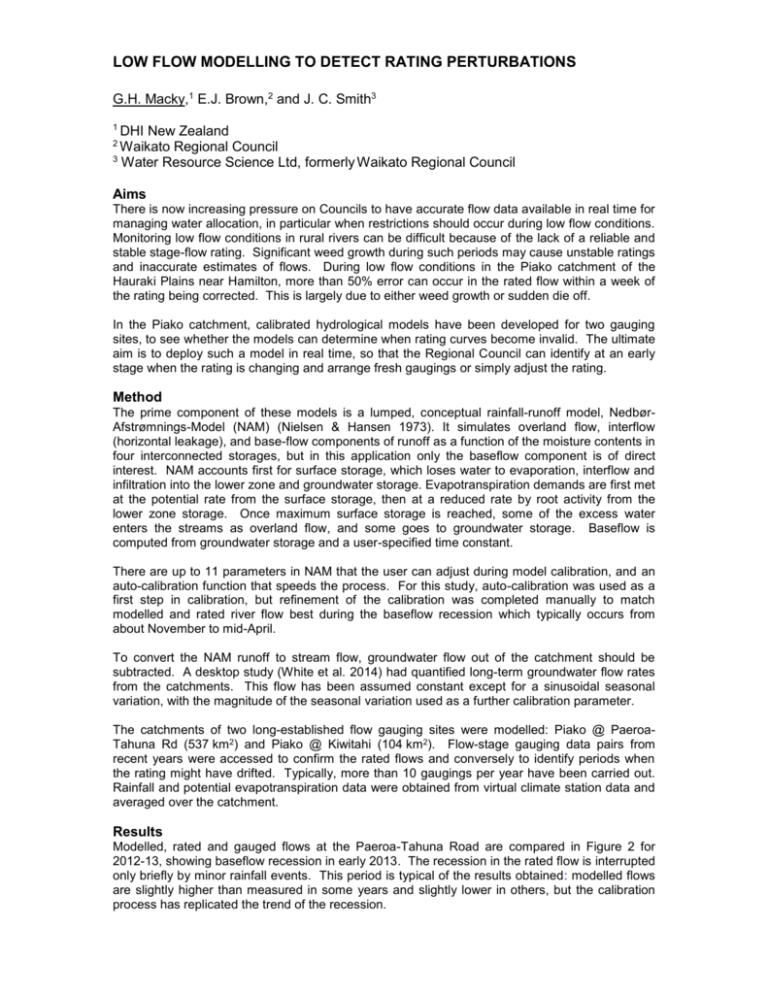
LOW FLOW MODELLING TO DETECT RATING PERTURBATIONS G.H. Macky,1 E.J. Brown,2 and J. C. Smith3 1 DHI New Zealand Waikato Regional Council 3 Water Resource Science Ltd, formerly Waikato Regional Council 2 Aims There is now increasing pressure on Councils to have accurate flow data available in real time for managing water allocation, in particular when restrictions should occur during low flow conditions. Monitoring low flow conditions in rural rivers can be difficult because of the lack of a reliable and stable stage-flow rating. Significant weed growth during such periods may cause unstable ratings and inaccurate estimates of flows. During low flow conditions in the Piako catchment of the Hauraki Plains near Hamilton, more than 50% error can occur in the rated flow within a week of the rating being corrected. This is largely due to either weed growth or sudden die off. In the Piako catchment, calibrated hydrological models have been developed for two gauging sites, to see whether the models can determine when rating curves become invalid. The ultimate aim is to deploy such a model in real time, so that the Regional Council can identify at an early stage when the rating is changing and arrange fresh gaugings or simply adjust the rating. Method The prime component of these models is a lumped, conceptual rainfall-runoff model, NedbørAfstrømnings-Model (NAM) (Nielsen & Hansen 1973). It simulates overland flow, interflow (horizontal leakage), and base-flow components of runoff as a function of the moisture contents in four interconnected storages, but in this application only the baseflow component is of direct interest. NAM accounts first for surface storage, which loses water to evaporation, interflow and infiltration into the lower zone and groundwater storage. Evapotranspiration demands are first met at the potential rate from the surface storage, then at a reduced rate by root activity from the lower zone storage. Once maximum surface storage is reached, some of the excess water enters the streams as overland flow, and some goes to groundwater storage. Baseflow is computed from groundwater storage and a user-specified time constant. There are up to 11 parameters in NAM that the user can adjust during model calibration, and an auto-calibration function that speeds the process. For this study, auto-calibration was used as a first step in calibration, but refinement of the calibration was completed manually to match modelled and rated river flow best during the baseflow recession which typically occurs from about November to mid-April. To convert the NAM runoff to stream flow, groundwater flow out of the catchment should be subtracted. A desktop study (White et al. 2014) had quantified long-term groundwater flow rates from the catchments. This flow has been assumed constant except for a sinusoidal seasonal variation, with the magnitude of the seasonal variation used as a further calibration parameter. The catchments of two long-established flow gauging sites were modelled: Piako @ PaeroaTahuna Rd (537 km2) and Piako @ Kiwitahi (104 km2). Flow-stage gauging data pairs from recent years were accessed to confirm the rated flows and conversely to identify periods when the rating might have drifted. Typically, more than 10 gaugings per year have been carried out. Rainfall and potential evapotranspiration data were obtained from virtual climate station data and averaged over the catchment. Results Modelled, rated and gauged flows at the Paeroa-Tahuna Road are compared in Figure 2 for 2012-13, showing baseflow recession in early 2013. The recession in the rated flow is interrupted only briefly by minor rainfall events. This period is typical of the results obtained: modelled flows are slightly higher than measured in some years and slightly lower in others, but the calibration process has replicated the trend of the recession. This result means that this graphical comparison of modelled and measured flows should clearly indicate when rated flow data become inaccurate due to weed growth, weed die-off or bed erosion or scour. The model for the Piako @ Paeroa-Tahuna Rd is now being set up to run in real time, linked to the same real-time rainfall and flow information as the flood forecasting system for the Hauraki basin. Some adjustment of model parameters may be desirable because the nearest rainfall data available in real time are at sites outside the catchment. Regardless, the real-time model will provide a useful early indicator that a stage-flow rating has significantly changed. With experience, it should be practicable to apply an adjusted rating prior to obtaining and analysing a new gauging. Based on past flow records and past gauging programme, this would allow a management response to decreasing flows 2-4 weeks earlier than has previously been possible. Deploying the model is therefore expected to help the Regional Council understand low-flow patterns and manage abstractions within the catchment. References Nielsen, S.A. & Hansen, E. (1973) Numerical simulation of the rainfall runoff process on a daily basis. Nordic Hydrology, 4, 171-190. White, P.A., Tschritter C. & Rawlinson Z. (2014) Water budgets in the Piako catchment, Hauraki Plains. Letter Report, GNS. Figure 1 Figure 2 Piako River at Paeroa-Tahuna Rd, looking downstream Piako River at Paeroa-Tahuna Rd, modelled, gauged and rated flows, July 2012 – June 2013.

